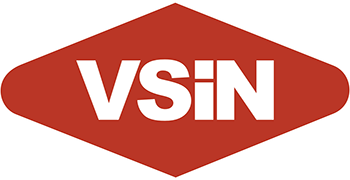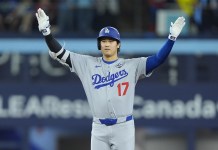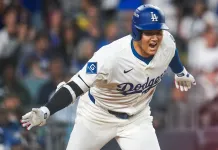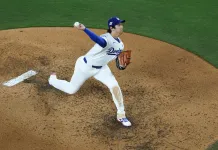Mariners vs. Blue Jays
The Blue Jays will tell you that they didn’t care whether or not they matched up against the Tigers or Mariners, but they surely had to enjoy watching a dramatic winner-take-all Game 5 that needed 15 innings to determine a winner. By the time it was all said and done, Seattle needed 34 pitches from Logan Gilbert and 15 pitches from Luis Castillo in extras to cobble together a win, along with extended appearances from Matt Brash and Andres Munoz. So, it sure seems like Toronto has the Game 1 advantage in the best-of-seven Mariners vs. Blue Jays ALCS.
Not only that, but Seattle had to play 15 innings and then fly on the off day to Toronto, with more than a few guys likely nursing hangovers. The Blue Jays were able to get their partying done on Wednesday night after defeating the Yankees in four games.
Home-field advantage has the chance to be a huge factor for Toronto here. As we saw in their two home playoff games, they scored 23 runs against Yankees pitching. The Blue Jays were the best offense in baseball at home, but Seattle was the second-best offense on the road. So, we have the potential for some runs in this series, at least at Rogers Centre. But, it is cool that no matter what, the Blue Jays haven’t made the World Series since 1993 and the Mariners have never made it, so it is going to be a special event for whoever advances.
Toronto took four of the six head-to-head regular season meetings, but those games were played April 18-20 and May 9-11, so it’s been a while.
Let’s break down the three main phases of the game – offense, pitching, defense – and see if there’s an edge to be had.
Mariners vs. Blue Jays ALCS Odds
Seattle Mariners -105 // Toronto Blue Jays -115
Odds as of 9 a.m. PT from DraftKings Sportsbook on Saturday, October 11
Mariners vs. Blue Jays ALCS Preview
Offense
Toronto batted a robust .338/.373/.601 in the series against the Yankees, scoring 34 runs on 50 hits. They also hit nine home runs. Maybe the most impressive stat is that Toronto struck out just 24 times in the four games. They put a ton of balls in play and that has been a critical element of their success all season long. They didn’t even hit the ball overly hard relative to the league average Hard Hit% and Barrel% marks. But, they hit a lot of balls. The Blue Jays’ 4,496 batted ball events were the most in baseball by 88 over the Royals.
Seattle, meanwhile, was 19th in batted ball events with 4,120, a glaring example of the difference between these two lineups. The Mariners struck out 347 more times than the Blue Jays in the regular season. They scored 19 runs over five games against the Tigers and struck out 58 times, though it should obviously be mentioned that Toronto doesn’t have Tarik Skubal.
Where Seattle does have an advantage, and it’s a surprising one given their home ballpark, is in the power department. The Mariners were third in MLB in homers with 238. Cal Raleigh certainly did his part in that department, but this is a team that was also third in HR/FB%. On the whole, Toronto’s pitching staff only had a 39.5% GB% and had the seventh-highest HR/FB% against. Seattle will need to hit the long ball to keep pace with Toronto’s offense in this series.
While there is a lot of opportunity to mix and match with quite a few lefties in the bullpen, the guys who will work the bulk innings for the Blue Jays are right-handed. Kevin Gausman will get the Game 1 start and then Trey Yesavage in Game 2. Yesavage is a huge swing-and-miss guy, so that seems like a tough matchup for a swing-and-miss lineup like Seattle’s.
The Mariners were third in wRC+ against righties during the season, posting a .246/.325/.422 slash. But, once again, their K% in that split was more than 5% higher than Toronto’s. Seattle’s rotation is also very right-handed-heavy, and Toronto was fourth in wOBA at .331, batting .266/.332/.431. Both lineups seem to match up relatively well.
But, I do prefer Toronto’s lineup here. Even though I’ve preached about power production in the playoffs and Seattle has the edge there, the Blue Jays are going to have more hits and more run-scoring opportunities in all likelihood. Seattle’s higher K% is a lot for me to overlook here, especially against an elite contact lineup like Toronto’s.
Advantage: Blue Jays
Pitching
Inherently, Toronto has the edge here because they’ve been able to set up their pitching staff properly by finishing the Yankees in four games instead of five. But, this is a terrific group of hurlers on the Seattle side and it’s not like Luis Castillo and Logan Gilbert had heavy workloads in Game 5. I think Game 1 is obviously a tricky spot, but beyond that, I think the impact will be minimal.
Gausman went 5.2 innings against the Yankees with one run allowed on four hits. He only struck out three and walked two. But, something that I mentioned heading into that series is how the Blue Jays were all on extended layoffs, something that the Mariners also had to deal with. Now that everybody has been able to knock off the rust, I would think that it’s beneficial.
Yesavage was masterful in his first career playoff start with 11 strikeouts out of 18 batters in 5.1 innings of work. He only walked one and didn’t allow a hit. He’s got one of the nastiest splitters in baseball and Gausman is also known for a splitter. You don’t really see them all that often, but the Mariners were 20th in Statcast Batting Runs against splitters.
The Mariners did really well hitting against curveballs, so we’ll see what that means when they match up against Shane Bieber, likely in Game 3. Bieber almost exclusively works the outer half of the plate and Seattle had the seventh-highest Oppo% in the league offensively, so we’ll see if that ends up being a good matchup for them.
Seattle also boasted one of the league’s top offenses against sinkers, but the Blue Jays throw very few of them, and most of them are from relievers. Jose Berrios would be the best matchup for the Mariners offense based on what they do well, so if he comes into a game or somehow gets a start, that might be a good live betting opportunity.
Seattle’s pitching staff is sinker/slider-heavy. The Blue Jays were an above average offense against both of those pitch types, as you would expect. Mariners pitchers don’t really use changeups, though, and that’s where the Blue Jays were at their best. This is a Toronto lineup that led the league by a large margin in offensive RHB vs. RHP numbers, so that’s something to keep in mind with all the righties in the rotation for the M’s.
Of course there are also the home/road splits for the Seattle staff. At home, the Mariners had a 3.28 ERA with a 3.63 FIP. On the road, they had a 4.50 ERA with a 4.34 FIP. Detroit’s offense was not very good and Comerica Park is a big, spacious outfield. Rogers Centre is a far more challenging venue.
From a bullpen standpoint, I don’t really love either relief unit. Toronto’s bullpen does miss more bats, but also issues more walks. The Jays pen was one of seven to have a double-digit BB%. The Reds were the only other bullpen of that group to make the playoffs and they didn’t stay long.
Between the Game 1 advantage and the home/road splits going to an actual good hitter’s park, I think Toronto has the edge here, too.
Advantage: Blue Jays
Defense
In looking at things defensively, the Blue Jays have a big edge. They finished the regular season ninth with +14 Outs Above Average, while the Mariners were 27th at -27. Seattle was especially bad around the horn, ranking 28th with -25 OAA on the infield. The Rogers Centre playing surface can speed up ground balls a bit and that could really be to Toronto’s advantage, as they were 13th in OAA.
I wrote about this in my Blue Jays-Yankees preview that Rogers Centre was a really good venue for ground ball batting average. Rogers Centre was fourth in BA and fourth in BA-xBA, as grounders had a .260 BA with a .250 xBA. Compare that to T-Mobile Park, where the BA was .240 with a .256 xBA, the second-highest BA-xBA gap to the negative side.
Toronto also has an edge behind the plate. Alejandro Kirk was second in Catcher Framing Runs behind Patrick Bailey of the Giants. Cal Raleigh was fifth, but nine CFR behind Kirk. Raleigh was a bit better at controlling the running game, but Toronto only had 77 stolen bases. We could see the Mariners try to be aggressive. They were third with 161 swipes, though they were only 2-for-4 against the Tigers. Dillon Dingler has the fastest average throwing speed at 85.3 mph. Kirk is about 6 mph slower than that, so Seattle may look to be more aggressive.
Still, with a huge gap in Outs Above Average and the infield conditions of Rogers Centre with an above average defense versus one of the worst infield defenses in the league, Toronto has the edge here as well.
Advantage: Blue Jays
Mariners vs. Blue Jays ALCS Prediction
Toronto is a big Game 1 favorite, but a relatively small favorite for the series. To me, they are the better all-around team and I’d expect them to have more run-scoring chances with their contact skills. Seattle’s rotation thrives on command more than overpowering stuff and Toronto’s hitters have exhibited some awesome plate coverage all season long.
With how Game 1 is shaping up, it would be hard not to take a Blue Jays series position. If they win Game 1, the series price is going to jump considerably. If you like Seattle, that might be a buy point, but I don’t know that they’re going to find much success in Games 1 or 2 based on the matchups and how the previous series ended.
Pick: Blue Jays -115






